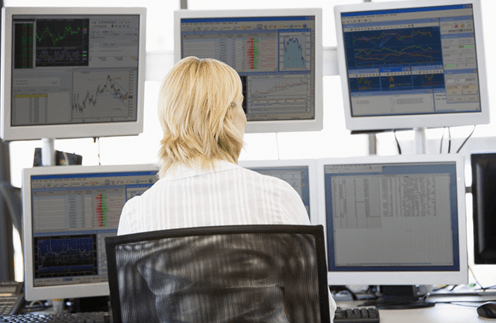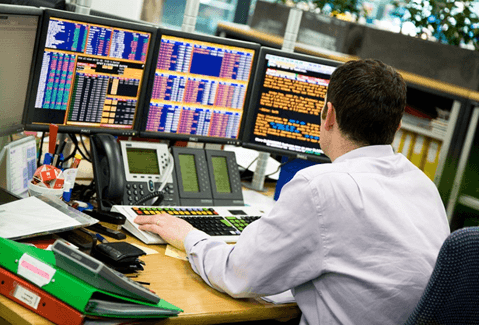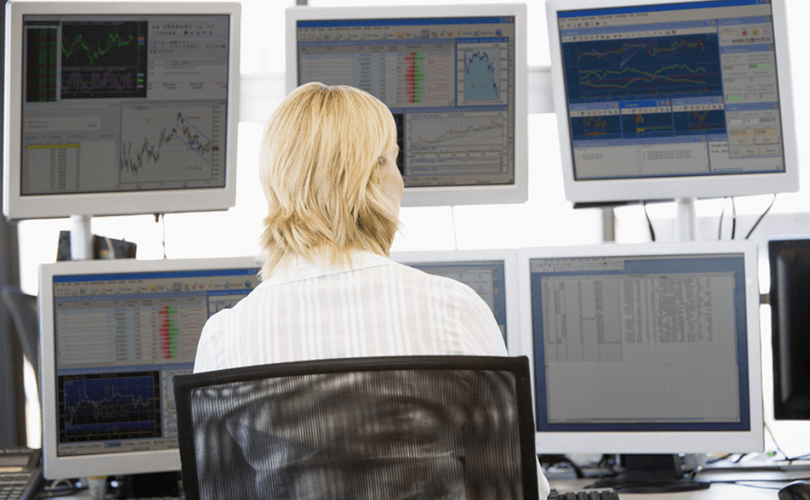Introduction: What Is Algorithmic Trading
Have you ever asked yourself, “What is algorithmic trading?” Many people have heard the term before, but they might not understand what it means. Algorithmic trading is the act of using preprogrammed computers to conduct profitable trades at speeds that are faster and more frequent than manual trading.



Image Source: BigStock
Computers are programmed with a set of specific instructions that they are forced to follow each time they make a trade. The instructions are basically a set of rules put in place for the trading, written in the form of mathematical equations and formulas.
The rules are based on algorithmic trading strategies created for a particular traded item using factors like quantity, price, and timing to make the right trading decisions.
Don’t Miss: What Is Consumer Credit? – Everything You Should Know (What Is Credit Counseling & a Credit Counselor?)
Benefits of Algorithmic Trading
Algo trading strategies like these are beneficial because they eliminate all human emotion that you would otherwise find in manual trading. Often times, traders who make decisions on their own will allow fear or excitement to overthrow their good judgment. This usually results in bad trades being made, which means more money lost.
Since algorithm trading doesn’t involve human emotion, every trade will be based strictly on the mathematical formulas programmed into the computer and nothing else. If the formulas were formed correctly and accurately, then the majority of the trades will be positive for the trader.
It is also more convenient for the trader because they don’t have to actively keep track of the market to watch trends on their stocks. Traders who check their stocks every day are typically the ones who let their emotions do the trading for them, which ends up resulting in disaster.
Here is a summary of the benefits:
- Automated trading that places orders instantly. This increases the chances of them successfully being executed.
- The timing of trades is strictly based on the price changes specified in the algorithm.
- Automated checks are performed simultaneously on the conditions of multiple trading markets.
- Less chance of human errors being made in trades.
- Helps ensure the trades are made at the best price possible.
- Most importantly, avoids human emotion from causing trading mistakes.
Disastrous Trading Example
Let’s look at an example of a disastrous trade decision based on emotion rather than algorithms. Suppose you purchase 200 shares of the Facebook stock and its price-per-share is increasing $0.05 every day. Then a week later, you wake up to check the stock’s price-per-share and see that it has dropped $3. This causes you to go into full panic mode and sell all of your shares because you’ve already lost money on your investment.
What you may not be factoring into this equation is the moving average over the last 150 to 200 days. Perhaps this stock has a habit of period dips before trending back upward in the long run. If you had kept your shares rather than selling them all, you could likely haven seen a profit again sometime in the future. But because you traded on your emotions rather than from a strict trading formula, you ended up conducting a disastrous trade.
The mathematical formulas involved in algo trading are not as complicated as one might think. You don’t have to be a rocket scientist or mathematician to create your own formulas. You just have to educate yourself on the market and understand how stocks become profitable in both the long-term and short-term. This ensures that you can execute trades at the best possible prices for your stocks whether you are selling them or buying them.
All-in-One Change Management Tools
Top Rated Toolkit for Change Managers.
Get Your Change Management Tool Today...
Algorithm Trading Example
Let’s take a look at an example that shows how to create a trading algorithm that could work for you in a real life trading situation. Suppose you were interested in trading the Ford Motor Company stock by purchasing 100 shares of it. Instead of just making the purchase at any given time, you’ll want to make the purchase at a particular point in time when the stock average is increasing steadily.
So, you could set the algorithm to purchase 100 shares of Ford when its 50-day moving average rises higher than its 150-day moving average. This will tell the computer to purchase those 100 shares at a time when the price-per-share is trending higher than the average 150-day trend. The reason this is a good time to purchase the stock is because the price-per-share will likely continue to go up after the trade is made. Then you would have already made a quick profit on your investment.
At this point, you can decide whether you want to sell your shares to get the cash or keep your shares in the hopes that their value will keep going up. If you are going to keep your shares, then you need to program another algorithm into the computer that tells it to sell those shares at a particular point in time. This would be a time when the moving average starts to sink, causing the price-per-share to decrease.
Obviously, you don’t want this to happen because it will cause you to lose the profit you made. If you wait too long to sell, you might even lose money on the initial investment that you made. Therefore, you would want to program the computer to sell those 100 shares of Ford when the stock’s 50-day moving average falls lower than the 150-day moving average. This will ensure that you get out of the stock in time before it starts to sink too much.
Types of Traders Who Use Algorithmic Trading
You don’t just have to be a long-term trader to use algo trading strategies in your trading practices. Algorithm trading is also commonly used by short-term traders, midterm traders, insurance companies, mutual funds, pension funds, speculators, market makers and systematic traders who follow trends.
Long-term and midterm investors are typically the ones who purchase large numbers of shares when they invest in a particular stock. However, they do it discretely so their investments do not influence the prices of those stocks. The insurance companies, mutual funds, and pension funds fall into this category.
Traders looking to make a quick profit, or flip, on the stock market are known as short-term traders. These are the arbitrageurs, speculators, and market makers who are constantly buying and selling every other day, week, or month. This helps stimulate the market by creating liquidity and increasing the daily volume of shares traded. Without this kind of activity, stock prices wouldn’t move very much at all.
As for systematic traders, these are the ones who implement algorithmic trading the most. They could care less about being just a short-term trader or long-term trader. All they care about are following the trends and programming their algorithmic software to execute a trade at a particular circumstance set in their formula.



Image Source: BigStock
Strategies of Algorithmic Trading
The previous example was just one of many algorithm trading strategies that you can use. It is easy to understand and a great way to help you learn algorithmic trading. However, there are other trading strategies that you can implement as well. Here are some of the most common strategies:
- Arbitrage Strategies – If you come across a dual-listed stock, which is when two corporations operate one business and are listed on two separate stock exchanges, then you could purchase the stock for a low price on one market and sell it for a higher price on another market. If you designed an algorithm to track dual-listed stocks that have varying prices on multiple stock exchanges, you could easily make a profit without much risk.
- Trend Strategies – This is the most common strategy where algorithms are designed to keep track of any moving averages, price level movements, channel breakouts, or any other sudden changes on the market. Then a trade can be programmed to execute based on a particular price or average from within these trends.
- Mean Reversion Strategies – Stock prices go up and down all the time, but they tend to stay around a particular mean value. The algorithm used with this strategy involves choosing a price range for your stock and programming the algorithm to trade automatically when the stock falls to the lowest or highest point in that range.
- Time-Weighted Strategies – If you want to minimize the impact from the changing market on your trading, use a time-weighted average price strategy. This is a strategy where you program the algorithm to break up large orders and execute them in small chunks over time slots divided evenly from the start time to the end time.



Algorithmic Trading Software
Algo trading strategies are easiest to apply with good quality algorithmic trading software. In order to find the best ones, you need to look up algorithmic trading software reviews on the internet to see which programs received positive feedback and which ones received negative feedback.
Algorithmic trading reviews can be found just by searching Google for premade trading software. There are two alternatives to trading software if you’d rather have more control over the programming of the algorithms. You can hire programmers to design software with your algorithms for you or you can program the software yourself. The easiest way is to use the premade software.
Here is what you will need to accurately trade and design accurate algorithm trading strategies:
- A computer less than five years old and a high-speed internet connection
- An online trading platform that lets you place orders
- Market data feeds
- The ability to test the algorithm trading strategies before they go live
Risks and Analyses
Algorithm trading does have its risks, and it is important you understand that nothing is 100% guaranteed with the algorithmic trading strategies you create. That is why it is important you start small with your trading until you know exactly what you are doing.
Technical errors are often common in algorithmic trading. Since everything is based on computers and network connectivity, all it would take is for the internet connection or computer system to unexpectedly fail, and you would have a trading problem. There could also be lagging times in between trade orders that are placed and executed.
But the most common failure when it comes to algorithmic trading is creating a bad algorithm that doesn’t work well for you. The more complex algorithms tend to be the ones that require the most testing. If you are just starting out, then you should stick with simple algorithms until you understand the process of creating them better.
Quantitative analysis should be used before implementing all algorithmic trading strategies onto the real market, and also after they are implemented. Even though this is a mostly automated process, you can’t just expect to sit back and make money without regularly performing quality control on your algorithms.
In the meantime, try learning computer programming so you will have the ability to build your own computer system that contains your own unique algorithmic trading strategies that no one else has. You may find this to be more profitable in the end.
Popular Article: What Is Debt Consolidation? – Is It Good or Bad? (Ways to Consolidate & Explanation)
AdvisoryHQ (AHQ) Disclaimer:
Reasonable efforts have been made by AdvisoryHQ to present accurate information, however all info is presented without warranty. Review AdvisoryHQ’s Terms for details. Also review each firm’s site for the most updated data, rates and info.
Note: Firms and products, including the one(s) reviewed above, may be AdvisoryHQ's affiliates. Click to view AdvisoryHQ's advertiser disclosures.





